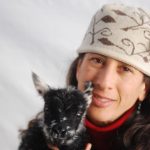Ergonomics and Fishing: Part 2

Toni Small of Ice House Oysters has been an aquaculture farmer with her husband John Cotton for five years. They currently farm diploid oysters in Port Clyde, Maine. John (62) has a traditional background in fishing, including tuna and other pelagic game fish, lobster, and groundfish. Toni (53) has a background in dance and became a certified yoga instructor in 2012.
Their goal is to grow their farm only large enough for the two of them to manage it without additional employees. As they are aging, they see the value of trying to do their tasks more ergonomically. Flipping oyster bags, loading and unloading them is more noticeable now on their bodies.
Tell us about your farm:
We have about 350,000 oysters in various stages of growth and added kelp about three years ago.
Tells us about your location:

Ice House Oysters
We live in Port Clyde, and farm year-round. Our first site was quite windy, making it difficult for us to farm due to wind and waves not just for safety, but oyster bags can get tangled. Last year, we moved the farm into a retired lobster pound. The warmer water in the pound increases their growth rate, and we don’t have to deal with the wind as much. We like to finish them off in the cove where they get tumbled naturally and develop a “cold water” flavor.
What is the physically hardest thing about aquaculture?
The stress of keeping an animal alive for 3-4 years. And lifting (20-50 pounds) in a crouched position, while balancing on a moving vessel, over and over again.
What have you done to address it?
I do a lot of squatting rather than bending over to reduce back pressure especially when I am loading bags in the pound. I work on good posture, and proper lifting techniques. In terms of lifting, I work on increasing my strength with weight lifting. I do it 2 times per week, and the results have worked, as I am lifting more easily, and have more endurance.
Do you employ adaptive techniques or specific equipment that helps you?
I use a stand-up paddle board in the pound to make it easier to flip the oyster seedlings, rather than bend over in the skiff. I can sit on the board, and because I am so close to the bag, it is easier. I use garden gloves that have a coating of rubber on the palm and fingers, but not on the back of the hand. I find these gloves allow me full mobility of my fingers, and the grip is better, and they are not bulky. They last more than a season. Our Novi boat is covered in marine mats that reduce leg fatigue, and provide better grip. We purchased an oyster tumbler, which reduces the repetitive tasks of sorting the oysters, and it also chips them, encouraging growth.
What future changes to provide better ergonomics would you make?
I would like another boom to go out over the pound to make it easier to haul oyster bags. We are switching from the standard oyster clip which is difficult to open, to the wider mouth clip which is easier to manipulate. Both the Novi boat and the oyster tumbler are loud, I would like to make changes to reduce the noise level.
If you are experiencing pain or injuries as a result of the rigors of fishing, or have a condition that presents challenges at work, Fishability offers free consultations on your boat or other worksite. Our staff will discuss techniques and equipment best suited to your needs to keep you working safer, more efficiently, and more comfortably. Fishability is dedicated to helping fishermen keep fishing.
